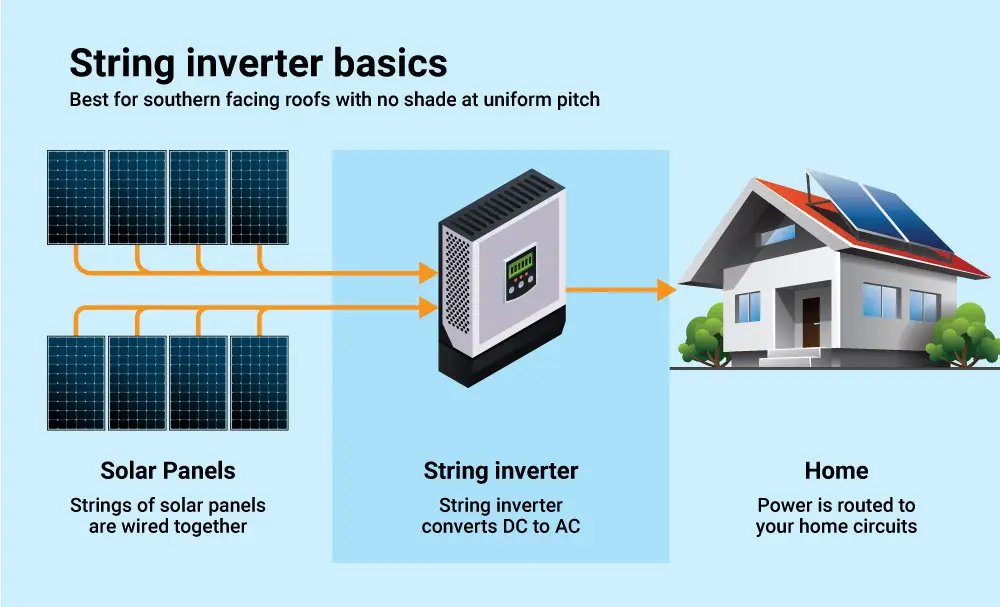Buy Solar String Inverter & Affordable Price In India.
Solar energy has evolved in recent years as a viable and environmentally benign alternative to traditional power sources. With the increased interest in renewable energy, solar string inverters have gained attention for their critical role in converting direct current (DC) supplied by solar panels into alternating current (AC) suited for residential and industrial usage. This article digs into the realm of solar string inverters, investigating its benefits, operation, and the most recent market trends in India.

What are Solar String Inverters?
Solar string inverters are an essential component of solar power systems. They are responsible for converting the direct current (DC) electricity generated by solar panels into alternating current (AC) electricity, which can be used to power homes, businesses, and industries. These inverters operate by stringing together multiple solar panels in a series, hence the name "string inverters."
How Do Solar String Inverters Work?

Solar string inverters work on a simple principle of converting DC to AC using semiconductor components. When sunlight falls on the solar panels, they generate DC electricity. The string inverter takes this DC electricity and converts it into AC electricity with a specific voltage and frequency, making it suitable for powering electrical appliances.
Types of Solar String Inverters
1. Microinverters
Microinverters are small inverters attached to each solar panel individually. They offer better performance in shaded or unevenly lit conditions as each panel operates independently. However, they can be costlier than other types.
2. Central Inverters
Central inverters are large inverters connected to a string of solar panels. They are cost-effective and efficient but can be affected by shading issues.
3. String Inverters
String inverters are the most common type used in solar installations. They are reliable, cost-effective, and easy to maintain, making them a popular choice for residential and commercial setups.
4. Hybrid Inverters
Hybrid inverters can work with both solar panels and battery storage systems, allowing users to store excess energy for later use. They provide energy independence and are ideal for areas with frequent power outages.
Advantages of Solar String Inverters
1. High Efficiency
Solar string inverters boast high conversion efficiencies, ensuring that more solar energy is utilized effectively.
2. Cost-Effectiveness
Compared to other types, string inverters are more affordable, making solar power systems accessible to a broader audience.
3. Scalability
Solar string inverters offer the flexibility to expand the system easily by adding more solar panels when needed.
4. Monitoring Capabilities
Many string inverters come with monitoring systems, allowing users to track their energy production and system performance in real-time.
5. Safety Features
String inverters have built-in safety features, such as anti-islanding protection, which ensure the safety of technicians during maintenance or repairs.
Factors Affecting Solar String Inverter Prices
The prices of solar string inverters can vary significantly based on several factors:
1. Brand and Reputation
Well-established and reputable brands often offer high-quality inverters but at a higher price point.
2. Power Capacity
The power capacity of the inverter determines how much electricity it can handle. Higher capacity inverters are generally more expensive.
3. Efficiency Ratings
Inverters with higher efficiency ratings tend to cost more due to their better performance.
4. Additional Features
Advanced features like smart grid integration or remote monitoring can contribute to higher prices.
5. Warranty and Support
Inverters with longer warranty periods and reliable customer support may have higher upfront costs.
Top Solar String Inverter Brands in India
India's solar market offers a wide range of string inverter brands. Some of the top brands known for their quality and performance include
Latest Technological Advancements
1. Maximum Power Point Tracking (MPPT) Technology
MPPT technology optimizes the efficiency of solar panels by finding the ideal operating point for maximum power extraction.
2. Anti-Islanding Protection
This safety feature ensures that the inverter shuts down during a power outage, preventing back-feeding into the grid and protecting utility workers.
3. Smart Grid Integration
Inverters equipped with smart grid integration can communicate with utility companies and adjust electricity production accordingly.
Installation and Maintenance
Proper installation and maintenance are crucial for the efficient functioning of solar string inverters. Consider the following:
1. Choosing the Right Location
Install the inverter in a well-ventilated area with minimal exposure to direct sunlight.
2. Proper Ventilation
Ensure adequate airflow around the inverter to prevent overheating.
3. Regular Cleaning and Inspection
Keep the inverter and its components clean and conduct routine inspections for any signs of wear or damage.
4. Professional Maintenance Services
Hire a professional for periodic maintenance and troubleshooting.
Government Incentives and Subsidies
The Indian government promotes solar adoption through various incentives and subsidies:
1. Solar Energy Schemes in India
The government has launched schemes to promote solar energy, offering financial support and incentives to consumers.
2. Financial Benefits for Solar Consumers
Tax benefits, subsidies, and net metering are some of the financial advantages available to solar consumers.
The Future of Solar String Inverters
As technology continues to advance, we can expect even more efficient and cost-effective solar string inverters. Innovations such as energy storage integration and improved grid management will drive the adoption of solar power further.
